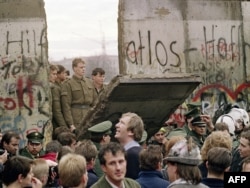WATCH: Czechs commemorated the Velvet Revolution by reenacting the 1989 student march that started it all.
By Kathleen Moore
PRAGUE -- In downtown Prague, dozens of children run after a motorized banana on wheels.
The race is entitled "What we'd be running after if it [the Velvet Revolution] never happened."
It's a humorous way to show those too young to remember communist rule that some things they take for granted, like bananas, were once in short supply.
It's just one of several events that drew thousands of people to the center of Prague to mark the 20th anniversary of the revolution that ended communist rule in Czechoslovakia.
Quick To Ignite
On November 17, 1989, it was a student march -- and its violent suppression by police -- that triggered mass street demonstrations. People's anger was stoked by a rumor, which later proved false, that a student had been killed.
Today, thousands of people took part in a reenactment of that original march.
There was a carnival atmosphere. Leading the march were two angels on stilts and a grotesque devil figure representing communism.
There were outsized symbols of the revolution -- giant keys like those that were jangled by tens of thousands of street demonstrators 20 years ago. And there were two actors playing "riot police officers" juggling their truncheons.
Bucking Authority
Unlike in Germany, where the government held major celebrations last week to mark the fall of the Berlin wall, the Czech events to mark November 17 were much smaller civic initiatives.
But that didn't dampen the spirit of some of the marchers.
"Czechs don't have that in them," says Alena Dokonalova. "Either it's spontaneous or people ignore it. Because we were brought up for 40 years to hate everything directed from above. So the fact it's spontaneous is great."
Another marcher, Josef Parlesak, seconds the view: "To direct something isn't so important as for so many people to come together voluntarily to celebrate. Just so long as we don't bump into nationalists, fascists, or communists!"
Hana Aksmanova and her friend Hana Zidlicka remember taking turns at babysitting so they could attend the huge street demonstrations in the weeks following November 17, 1989.
That month was "one endless huge party," Aksmanova says, adding, "We're very pleased to be here, that we're here 20 years on."
Zidlicka gently chides the younger generation, though.
Performers hold giant keys during the march in Prague. In 1989, Czechoslovaks jingled keys to symbolize the unlocking of doors.
"I told my sons to come with me today but they didn't want to," says Zidlicka. "They were here 20 years ago on their dad's shoulders as toddlers. Now they're 25 and 22. They aren't interested.""My daughter is here," Aksmanova takes exception, "I saw her at the tram. She's here, she's active -- girls are like that; boys are lazy couch-potatoes."
Potent Symbols
The marchers followed the original route of 1989, passing the riverside apartment that was once home to Vaclav Havel -- the dissident playwright who went on to lead the revolution and become president -- and his then wife, Olga Havlova.
A cheer went up as a lantern was lit and released in honor of Havlova.
Then, at the end of the march, at the site where police beat student demonstrators 20 years ago, a symbolic "Iron Curtain" fell in a blaze of fireworks.
Revolutions Of '89
When The Wall Came Down



















